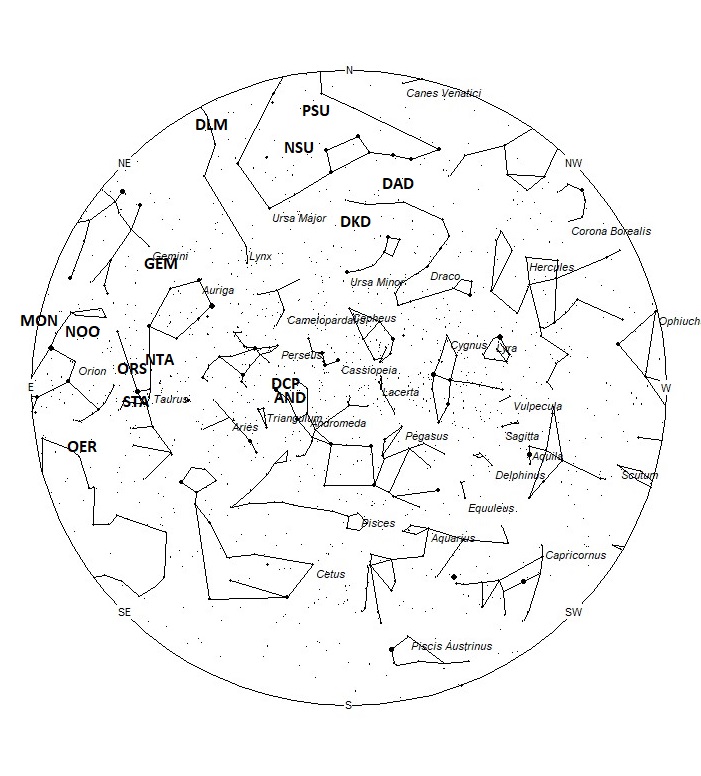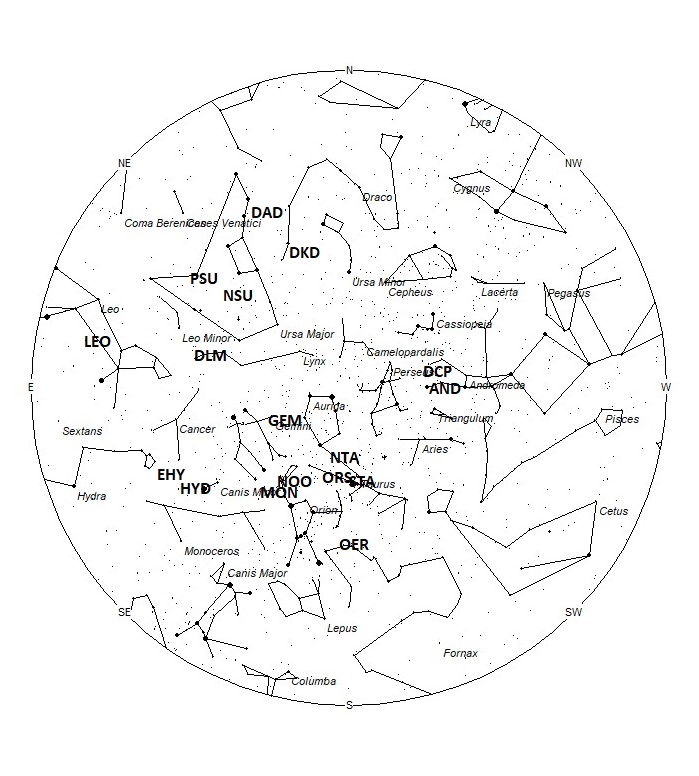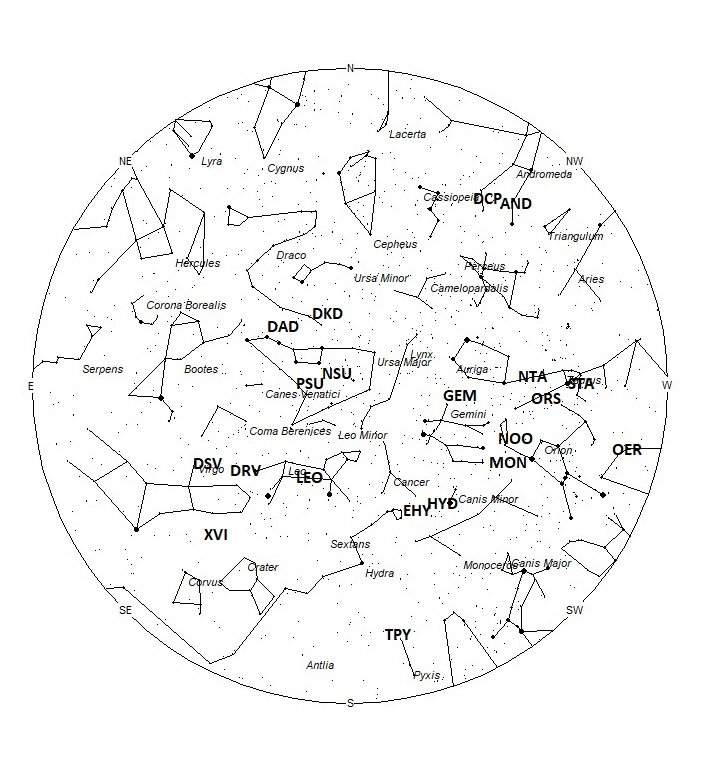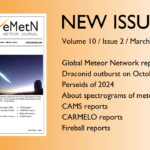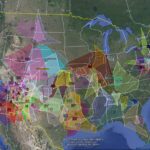During this period, the moon reaches its last quarter phase on Saturday November 27. At that time the moon will rise near 23:00 (on Nov. 26). This weekend the morning sky will be bathed in moonlight from the half-illuminated moon. If your sky is transparent, successful meteor observations can be undertaken under such circumstances. It helps to face a direction opposite the moonlight in order to sustain your night vision. As the week progresses the moon becomes less of a nuisance as its phase wanes, and it rises later in the morning with each passing night. The estimated total hourly meteor rates for evening observers this week is near 4 as seen from mid-northern latitudes (45N) and 3 as seen from tropical southern locations (25S). For morning observers, the estimated total hourly rates should be near 15 as seen from mid-northern latitudes (45N) and 7 as seen from tropical southern locations (25S). The actual rates will also depend on factors such as personal light and motion perception, local weather conditions, alertness, and experience in watching meteor activity. Morning rates during this period are reduced due to moonlight. Note that the hourly rates listed below are estimates as viewed from dark sky sites away from urban light sources. Observers viewing from urban areas will see less activity as only the brighter meteors will be visible from such locations.
The radiant (the area of the sky where meteors appear to shoot from) positions and rates listed below are exact for Saturday night/Sunday morning November 27/28. These positions do not change greatly day to day so the listed coordinates may be used during this entire period. Most star atlases (available at science stores and planetariums) will provide maps with grid lines of the celestial coordinates so that you may find out exactly where these positions are located in the sky. I have also included charts of the sky that display the radiant positions for evening, midnight, and morning. The center of each chart is the sky directly overhead at the appropriate hour. These charts are oriented for facing south but can be used for any direction by rotating the charts to the desired direction. A planisphere or computer planetarium program is also useful in showing the sky at any time of night on any date of the year. Activity from each radiant is best seen when it is positioned highest in the sky, either due north or south along the meridian, depending on your latitude. It must be remembered that meteor activity is rarely seen at the radiant position. Rather they shoot outwards from the radiant, so it is best to center your field of view so that the radiant lies at the edge and not the center. Viewing there will allow you to easily trace the path of each meteor back to the radiant (if it is a shower member) or in another direction if it is sporadic. Meteor activity is not seen from radiants that are located far below the horizon. The positions below are listed in a west to east manner in order of right ascension (celestial longitude). The positions listed first are located further west therefore are accessible earlier in the night while those listed further down the list rise later in the night.
These sources of meteoric activity are expected to be active this week.
.
The December Phoenicids (PHO) are a periodic shower that rarely produces noticeable activity. The only impressive display produced so far by this shower occurred in 1956 when ZHR’s were near 100. The normal rage for these meteors is from November 28 through December 9 with a peak on December 5. The radiant at maximum is located at 01:12 (018) -53. This position lies in southern Phoenix, 5 degrees south of the 3rd magnitude star known as beta Phoenicis. For those viewing from the northern tropics southward, this position also lies 7 degrees northwest of the bright 1st magnitude star known as Achernar (alpha Eridani). This area of the sky is best placed as soon as evening twilight ends. These meteors are best seen from the southern hemisphere where the radiant lies much higher in the sky. For those viewing from the northern hemisphere, only those in the northern tropics have any real chance of seeing activity from this source. At only 12 km/sec. the Phoenicids produce extremely slow meteors.
The December phi Cassiopeiids (DPC) are the classical return of the Andromedids and the radiant that was active prior to the breakup of comet 3D/Biela in the 1840’s. This source is active from November 28 through December 10th. Maximum activity is expected to occur on December 6th when the radiant is located at 01:36 (024) +50. This area of the sky is located just northwest of the 4th magnitude star known as Nembus (51 Andromedae). This position is also very close to the border with Cassiopeia and in some years the radiant lies in Cassiopeia, hence the name of phi Cassiopeiids. These meteors are best seen near 2100 (9pm) Local Standard Time (LST). Meteors from the December Phi Cassiopeiids strike the atmosphere at 17km/sec., which would produce meteors of very slow velocity. Expected rates are less than 1 per hour no matter your location.
The last of the Andromedids (AND) should appear this week from a radiant located near 01:42 (026) +42. This position lies in eastern Andromeda, 1 degree east of the 4th magnitude star known as Titawin (upsilon Andromedae A). This part of the sky is best placed near 2200 local standard time (LST), when the radiant lies highest above the horizon. Current rates would most likely be less than 1 per hour no matter your location. With an entry velocity of 14 km/sec., the average Andromedid meteor would be of very slow velocity.
The last of the Southern Taurids (STA) should appear from a large radiant located at 04:26 (67) +15. This area of the sky is located in central Taurus, 2 degrees southwest of the 2nd magnitude star known as Aldebaran (alpha Tauri). This radiant is best placed near 0100 LST, when it lies on the meridian and is located highest in the sky. Current rates should be near 1 per hour no matter your location. With an entry velocity of 21 km/sec., the average STA meteor would be of medium-slow velocity.
The omicron Eridanids (OER) was discovered by the Japanese video meteor network SonotaCo from video data obtained during 2007-2008. These meteors are active from October 23 through December 2nd. Maximum activity is ill-defined and may occur anytime from November 3-27. The date listed in the table represents the midpoint of the activity curve and not the actual date of maximum activity. The radiant is currently located at 04:34 (69) -03, which is located in eastern Eridanus, 2 degrees west of the 4th magnitude star known as mu Eridani. This radiant is best placed near 0100 local standard time (LST), when it lies on the meridian and is located highest in the sky. Rates at this time should be less than 1 per hour no matter your location. With an entry velocity of 26 km/sec., the average OER meteor would be of medium-slow velocity.
The last of the Northern Taurids (NTA) should be visible from a large radiant is located at 04:46 (71) +25. This area of the sky is located in northern Taurus, 3 degrees north of the 4th magnitude star known as tau Tauri Aa. This radiant is best placed near 0100 LST, when it lies on the meridian and is located highest in the sky. Rates at this time should be 2 per hour as seen from the Northern Hemisphere and 1 per as seen from south of the equator. With an entry velocity of 25 km/sec., the average NTA meteor would be of medium-slow velocity.
The Southern chi Orionids (ORS) are usually included in the totals of the Southern Taurids, as the two radiants are separated by only 5 degrees. Careful study of this area of the sky can separate these two showers. These meteors are active from November 14 through December 16, with maximum activity occurring on December 2nd. The radiant is currently located at 05:03 (76) +18, which lies in eastern Taurus, near the spot occupied by the faint star known as 104 Tauri. This radiant is best placed near 0100 LST, when it lies on the meridian and is located highest in the sky. Rates at this time should be near 1 per hour as seen from the Northern Hemisphere and less than 1 as seen from south of the equator. With an entry velocity of 27 km/sec., the average ORS meteor would be of medium-slow velocity.
The November Orionids (NOO) are active from November 13 through December 12, with maximum activity occurring on November 30th. The radiant is currently located at 06:00 (090) +16. This area of the sky lies on the in northeastern Orion, 2 degrees northwest of the 4th magnitude star known as nu Orionis. This radiant is best placed in the sky near 0200 LST, when it lies highest above the horizon. Rates should be near 2 per hour as seen from the Northern Hemisphere and 1 per hour as seen from south of the equator. With an entry velocity of 43 km/sec., most activity from this radiant would be of medium speed.
The Monocerotids (MON) are active from November 23 through December 24 with the peak activity occurring on December 11th. The radiant is currently located at 06:08 (092) +10. This position lies in northeastern Orion, 4 degrees northeast of the 1st magnitude orange star known as Betelgeuse (alpha Orionis). This position is only 7 degrees south of the radiant of the November Orionids so care must be taken to distinguish between the two. Current rates should be less than 1 per hour no matter your location. Rates at maximum may reach 2 per hour. The Monocerotids are best seen near 0200 LST when the radiant lies highest above the horizon. At 44 km/sec. the Monocerotids produce mostly meteors of medium velocity.
The Geminids (GEM) have recently been found to be active from November 19 through December 24. The early Geminids are sometimes referred to as the theta Aurigids (THA). The radiant is currently located near 06:28 (097) +35. This position lies in southeastern Auriga, between the two moderately bright stars known as theta Aurigae and theta Geminorum. Rates this weekend should be less than 1 per hour no matter your location. This radiant is best placed in the sky near 0200 LST, when it lies highest above the horizon. At 32 km/sec. the Geminids produce mostly meteors of medium velocity.
The sigma Hydrids (HYD) are active from a radiant located at 07:48 (117) +05. This area of the sky is located in eastern Canis Minor, 2 degrees east of the bright zero magnitude star known as Procyon (alpha Canis Minoris). Current rates should be near 1 per hour no matter your location. Rates will climb to 2-3 per hour as conditions improve through the week. These meteors are best seen near 0300 LST, when it lies highest above the horizon in a dark sky. With an entry velocity of 59 km/sec., the average sigma Hydrid meteor would be of swift velocity.
The Puppid-Velids (PUP) are a vast complex of weak radiants located in the constellations of Puppis and Vela. Visual plots and photographic studies have revealed many radiants in this area during November and December. The combined strength of these radiants can produce a ZHR of 10. Actual hourly rates will be much less unless you happen to be observing from the deep Southern Hemisphere. Activity from this source begins around December 1st. The center of this activity is currently located at 08:10 (122) -45. This position lies in western Vela, 2 degrees northeast of the 2nd magnitude star known as gamma Velorum. Peak rates occur near December 7. These meteors are best seen near 0300 LST when the radiant lies highest above the horizon in a dark sky. Observers located in the Southern Hemisphere have an advantage viewing this shower as the radiant will rise higher into their sky allowing more activity to be seen. Since the radiant lies low in the south for most northern hemisphere observers, meteors seen from north of the equator tend to be long in length and long-lasting. At 40 km/sec. the Puppid-Velids produce meteors of average velocity. Note: these are also listed as the “e Velids” from several sources.
The eta Hydrids (EHY) were recently discovered by members of the Croatian Meteor Network. This radiant is active from November 26 through January 1st with maximum activity occurring on December 12th. The radiant is currently located at 08:16 (124) +04, which places it in extreme western Hydra, 4 degrees northwest of the 4th magnitude star known as theta Hydrae. This position is close to that of the sigma Hydrids so care must be taken to separate the two sources. These meteors are best seen near 0400 LST when the radiant lies highest above the horizon. Current rates should be less than 1 per hour no matter your location. With an entry velocity of 62 km/sec., most activity from this radiant would be of swift speed.
The theta Pyxidids (TPY) consist of two weak showers that peak two weeks apart. The early version is active from November 27 through December 7 with maximum occurring on December 1st. The radiant is currently located at 09:04 (136) -26. This area of the sky is located in northeastern Pyxis, just west of the faint star known as kappa Pyxidis. These meteors are best seen near 0400 LST when the radiant lies highest above the horizon. At 58 km/sec. the theta Pyxids would produce mostly swift meteors.
The December Leonis Minorids (DLM) are a shower of long duration active from December 1st all the way through February 10th. Maximum occurs near December 19th when rates may reach 3 an hour. During this period, I would expect hourly rates of less than 1 from a radiant located at 09:20 (140) +39. This position lies in eastern Lynx, 2 degrees north of the 4th magnitude star known as 38 Lyncis. These meteors are best seen near 0400 LST when the radiant lies highest above the horizon. At 63 km/sec. the December Leonis Minorids produce mostly swift meteors. These meteors are known most commonly as the Comae Berenicids.
The November sigma Ursae Majorids (NSU) are active from November 17 through December 2 with the peak activity occurring on November 24th. The radiant is currently located at 10:10 (154) +57. This position lies in western Ursa Major, 7 degrees west of the 2nd magnitude star known as Merak (beta Ursae Majoris). Current rates should be less than 1 per hour no matter your location. The NSU’s are best seen near 0100 LST when the radiant lies highest above the horizon during the last hour before dawn, when it lies highest above the horizon in a dark sky. At 57 km/sec. the NSU’s would produce mostly meteors of swift velocity.
The psi Ursa Majorids (PSU) were discovered by observers in Japan using data from SonotaCo. This shower is active from November 29-December 11 with maximum activity occurring on December 4th. The radiant is currently located at 10:48 (162) +48. This position lies in southern Ursa Major, 4 degrees northwest of the third magnitude star known as psi Ursae Majoris. This area of the sky is best placed during the last hour before dawn, when it lies highest above the horizon in a dark sky. Current rates would most likely be less than one per hour no matter your location At 60km/sec., the average psi Ursa Majorid meteor would be swift.
The Leonids (LEO) are active from November 03-December 02 with maximum activity occurring on November 18th. The radiant is currently located at 10:41 (160) +18. This position lies in central Leo, 4 degrees southeast of the 2nd magnitude star known as Algieba (gamma Leonis A). The Leonid radiant is best placed during the last hour before morning twilight when the radiant lies highest in a dark sky. Leonids may be seen from the Southern Hemisphere, but the viewing conditions are not quite as favorable as those north of the equator. Current rates are expected to be less than 1 per hour no matter your location. With an entry velocity of 71 km/sec., most activity from this radiant would be of swift speed with numerous persistent trains on the brighter meteors.
The December kappa Draconids (DKD) were discovered by SonotaCo during studies of new radiants in 2008-09. This shower is active from November 29 through December 13 with maximum activity occurring on December 3rd. The radiant is currently located at 11:53 (178) +73. This position lies in extreme western Draco, 4 degrees north of the 4th magnitude star known as lambda Draconis. While the radiant lies above the horizon all night for most of the northern hemisphere, it is best placed during the last hour before dawn, when it lies highest above the horizon in a dark sky. Rates could reach 1 per hour on the morning of the 3rd. Away from that morning I would expect hourly rates of less than 1. Due to the high northerly declination of the radiant these meteors are not visible from most of the southern hemisphere. At 43km/sec., the average December kappa Draconid meteor would be of medium velocity.
The December rho Virginids (DRV) are active from November 29 through December 22 with peak rates occur near December 5th. The current radiant location is at 11:55 (179) +14 which places it in eastern Leo, 1 degree east of the 2nd magnitude star known as Denebola (beta Leois). Current hourly rates would be less than 1 no matter your location. These meteors are best seen during the last dark hour before dawn, when the radiant lies highest above the horizon in a dark sky. At 66 km/sec. the December rho Virginids would produce mostly swift meteors.
The December chi Virginids (XVI) 2009are another shower discovered in Japan by observers using data from SonotaCo. This source is active from November 26 through December 30 with maximum occurring on December 12th. The radiant is currently located at 12:01 (180) -04, which places it in southwestern Virgo, 4 degrees southwest of the 4th magnitude star known as Zaniah (eta Virginis A). Hourly rates should be near 1 no matter your location. These meteors are best seen during the last dark hour before dawn, when the radiant lies highest above the horizon in a dark sky. At 68 km/sec. the December chi Virginids would produce mostly swift meteors.
The December sigma Virginids (DSV) is a source of long duration discovered by John Greaves using the data of SonotaCo. This source is active from November 26 through January 24 with peak rates occur near December 21st. The current radiant location is at 12:28 (187) +10 which places it in northwestern Virgo, 6 degrees west of the 3rd magnitude star known as Vindemiatrix (epsilon Virginis). Current hourly rates would be less than 1 no matter your location. These meteors are best seen during the last dark hour before dawn, when the radiant lies highest above the horizon in a dark sky. At 69 km/sec. the December Sigma Virginids would produce mostly swift meteors.
The December alpha Draconids (DAD) were discovered by the Japanese observers using data from SonotaCo. This source is active from November 30-December 15, with maximum activity occurring on December 8th. The radiant is currently located at 13:13 (198) +61. This position actually lies in northeastern Ursa Major, 6 degrees northwest of the second magnitude star known as Mizar (zeta Ursae Majoris). These meteors are best seen during the last dark hour before dawn, when the radiant lies highest above the horizon in a dark sky. This shower is not well seen from the southern hemisphere. Current rates would most likely be less than 1 per hour no matter your location. At 44 km/sec. meteors from this source would produce mostly medium velocity meteors.
As seen from the mid-northern hemisphere (45N) one would expect to see approximately 9 sporadic meteors per hour during the last hour before dawn as seen from rural observing sites. Evening rates would be near 3 per hour. As seen from the tropical southern latitudes (25S), morning rates would be near 7 per hour as seen from rural observing sites and 2 per hour during the evening hours. Locations between these two extremes would see activity between the listed figures. Evening rates are reduced by moonlight.
You can keep track of the activity of these meteor showers as well as those beyond the limits of visual observing by visiting the NASA Meteor Shower Portal available at: https://meteorshowers.seti.org/ You can move the sky globe to see different areas of the sky. Colored dots indicate shower meteors while white dots indicate sporadic (random) activity. The large orange disk indicates the position of the sun so little activity will be seen in that area of the sky.
| SHOWER | DATE OF MAXIMUM ACTIVITY | CELESTIAL POSITION | ENTRY VELOCITY | CULMINATION | HOURLY RATE | CLASS |
| RA (RA in Deg.) DEC | Km/Sec | Local Standard Time | North-South | |||
| December Phoenicids (PHO) | Dec 05 | 01:12 (018) -53 | 12 | 21:00 | <1 – <1 | III |
| December phi Cassiopeiids (DPC) | Dec 06 | 01:36 (024) +50 | 17 | 22:00 | <1 – <1 | III |
| Andromedids (AND) | Nov 06 | 01:42 (026) +42 | 14 | 22:00 | <1 – <1 | IV |
| Southern Taurids (STA) | Nov 05 | 04:26 (067) +15 | 21 | 01:00 | <1 – <1 | II |
| omicron Eridanids (OER) | Nov 13 | 04:34 (069) -03 | 26 | 01:00 | <1 – <1 | IV |
| Northern Taurids (NTA) | Nov 12 | 04:46 (071) +25 | 25 | 01:00 | 1 – <1 | II |
| Southern chi Orionids (ORS) | Dec 02 | 05:03 (076) +18 | 27 | 01:00 | 1 – <1 | IV |
| November Orionids (NOO) | Nov 30 | 06:00 (090) +16 | 43 | 02:00 | 2 – 1 | II |
| Monocerotids (MON) | Dec 11 | 06:08 (092) +10 | 44 | 02:00 | <1 – <1 | II |
| sigma Hydrids (HYD) | Dec 07 | 07:48 (117) +05 | 59 | 03:00 | 1 – 1 | II |
| Puppid-Velids (PUP) | Dec 07 | 08:10 (122) -45 | 40 | 04:00 | <1 – <1 | II |
| eta Hydrids (EHY) | Dec 12 | 08:16 (124) +04 | 62 | 04:00 | <1 – <1 | II |
| theta Pyxidids (TPY) | Dec 01 | 09:04 (136) -26 | 58 | 05:00 | <1 – <1 | IV |
| December Leonis Minorids (DLM) | Dec 19 | 09:20 (140) +39 | 63 | 05:00 | <1 – <1 | II |
| November sigma Ursae Majorids (NSU) | Nov 24 | 10:10 (154) +57 | 57 | 06:00 | <1 – <1 | IV |
| Leonids (LEO) | Nov 18 | 10:41 (160) +18 | 71 | 06:00 | 1 – <1 | I |
| psi Ursa Majorids (PSU) | Dec 04 | 10:48 (162) +48 | 60 | 07:00 | <1 – <1 | IV |
| December kappa Draconids (DKD) | Dec 03 | 11:53 (178) +73 | 43 | 08:00 | <1 – <1 | IV |
| December rho Virginids (DRV) | Dec 05 | 11:55 (179) +14 | 66 | 08:00 | <1 – <1 | IV |
| December chi Virginids (XVI) | Dec 12 | 12:01 (180) -04 | 68 | 08:00 | <1 – <1 | IV |
| December sigma Virginids (DSV) | Dec 21 | 12:28 (187) +10 | 69 | 08:00 | <1 – <1 | IV |
| December alpha Draconids (DAD) | Dec 08 | 13:13 (198) +61 | 44 | 09:00 | <1 – <1 | IV |

